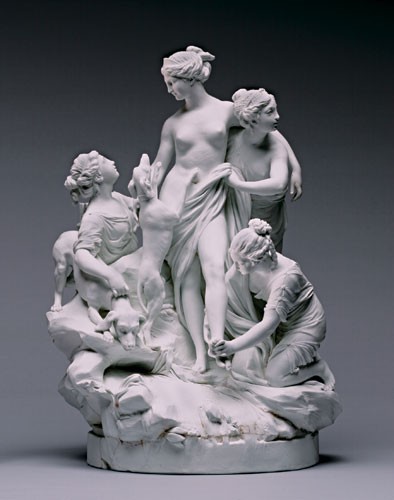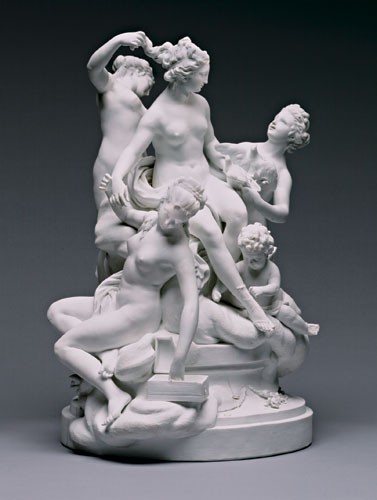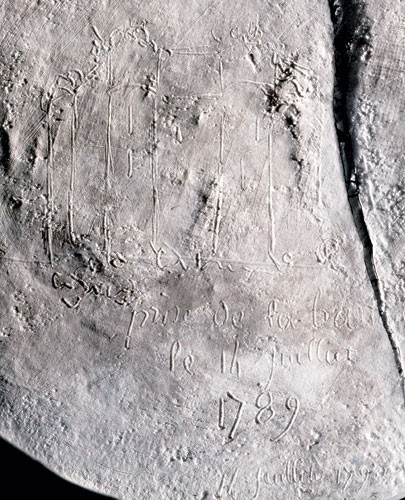
Diana au Bain, Royal Porcelain Factory, Sèvres, ca. 1790. Hard-paste porcelain. H. 14 1/2". (Courtesy, Philadelphia Museum of Art; photos, Graydon Wood.)

La Toilette de Vénus, Royal Porcelain Factory, Sèvres, ca. 1790. Hard-paste porcelain. H. 14 1/4".

Underside of the group illustrated in fig. 2.
Following the Revolution, Americans increasingly turned to France for guidance in matters of taste. By the 1780s Americans—most notably George Washington and Thomas Jefferson—were acquiring French porcelain, particularly dinner and coffee and tea services, and furnishing their tables with centerpieces, or surtout, consisting of plateaus of silver and glass and figures in biscuit porcelain, in the fashion established in France earlier in the century.[1] It would appear that as the vogue for setting the table with a surtout was so new, Americans often needed instruction about how to arrange the figures. Gouverneur Morris, who acted as Washington’s agent in Paris, included in correspondence accompanying a shipment of a surtout a description of the placement of the biscuit figures.[2] Among the items in an order placed with Oxley Hancock and Co. by Edward Lloyd IV and his wife, Elizabeth, of Wye House, Maryland, on January 17, 1792, is a “Fashionable Ornamental decoration to set off a Dining or Supper Table, that will accommodate 20 people with a Sketch of the Images . . . thereon Plain and full Directions showing how the ornaments are to be Placed there.”[3]
Figures in biscuit porcelain were first introduced about 1752 at the Vincennes—later, the Sèvres—porcelain factory in France. An immediate success, biscuit figures subsequently were produced by porcelain factories throughout Europe. In the collection of the Philadelphia Museum of Art are two biscuit figure groups, Diana au Bain (fig. 1) and La Toilette de Vénus (fig. 2), made at Sèvres about 1790.[4] The museum purchased them in 1945 from Mrs. William R. Cabot, a descendant of the Boston merchant Thomas Handasyd Perkins (1764–1854). Perkins, a prominent member of the Federalist party, probably bought them during a trip to Paris in 1795, part of an extended European tour that began in Bordeaux in December 1794. It is unlikely that figure groups of this scale and quality would have been available at the time through an American retailer.
The Perkins Papers, preserved at the Massachusetts Historical Society, contain Perkins’s journals, including those written during his stay in Paris between March 12 and May 21, 1795. A trip to the Sèvres manufactory is recorded in the journal entry for 7 floréal year 3 of the Republican calendar (April 26–27, 1795):
This day, Messrs. Codman, Deblois, and myself went to see the famous manufacture of porcelain at Sèvres, about seven miles from Paris. The building is very large, and surrounded by gardens under the highest cultivation, and magnificent country-seats. The porcelain made at Sèvres has the reputation of being the finest in the world. Some pieces there have no price, particularly two pictures painted on china, which are celebrated as masterpieces of art. . . . We were shown cups which cost several guineas each in the best of times. For one service of porcelain which was displayed, they asked one hundred and fifty thousand livres: and, as they do not add on these valuable articles more than fifty per cent upon the old prices, this must have been valued at nearly twenty thousand dollars before the revolution.
Perkins goes on to say that he and Codman “bought a number of trifles” on that day, and although his purchases are not recorded in the factory sales records, Codman’s purchases are. Among them is the biscuit group Minerve protégeant l’Étude et foudroyant la Paresse, for which he paid the princely sum of 750 livres, and an enameled blue pedestal for the group that cost 720 livres. Codman spent a total of 2,930 livres.
Also among Perkins’s papers is an “Account of My Private Expenses at Bordeaux & Paris” that Perkins recorded on his return to Boston in January 1796. Included in the items paid is 1,492 livres for “porcelain figures & pictures at Sevres manufactory.”[5] In the same account, he records having paid 643 livres for “8 China figures bought Rue du Temple.”[6]
An inventory of Perkins’s Boston residences taken at the time of his death in 1854 records a number of biscuit figures. One group—perhaps La Toilette de Vénus—included in the decorations of the sitting room of the house in Temple Place is valued at ten dollars, as is another group, identified as Diana and Nymphs and included in the sculpture at Brockline House.
While it seems likely that Perkins purchased the figures directly from the Sèvres factory, it is possible that he acquired them elsewhere in Paris during the same visit. The Boston Athenaeum has two marbles given by Perkins, a bust of Raphael by an unidentified artist, and a bust of Peter Paul Rubens by Jean Villette. In 1851, at the request of the Athenaeum, Perkins wrote down his recollections of the circumstances under which he acquired these busts; he may have purchased the porcelain figure groups under similar circumstances.
When I was in Paris in 1794,5 I met with my friend the late Col. John Trumbull, who was on the Continent attending to the engraving of his Battle of Bunker Hill and The Death of Montgomery—Whilst in Paris he employed his leisure time in Collecting Old Paintings, and works in marble, under the advice and aid of M Le Brun # (the Grandson of the celebrated Le Brun, who painted the Ceilings of the Palace of Versailles, with the Battles of Alexander).
At that period, amny [sic] of the works of Art of the Old Masters, had left their stations on the Walls or in the Halls of the Nobility of france, and fallen into the hands of Brokers and sellers of furniture—It was from one of these that Col. Trumbull purchased the busts now presented to the Athenaeum.
On the bottom of the museum’s figure of Venus is the outline of a building resembling the Bastille and the inscription “prise de la bastille le 14 juillet 1789” with the date “juillet 1790”—an obvious reference to the storming of the Bastille prison by an angry mob in the early days of the French Revolution (fig. 3). How this inscription came to be on the figure is unknown, but its meaning certainly would not have escaped Perkins, who witnessed the execution by guillotine of sixteen members of the Revolutionary tribunal after the fall of Robespierre. He later wrote with some understatement that his visit took place during “a very interesting period in the French Revolution.”
Donna Corbin, Assistant Curator, European Decorative Arts, Philadelphia Museum of Art; DCorbin@philamuseum.org
For a discussion of French porcelain in America during the period, see Susan Gray Detweiler, “French Porcelain on Federal Tables,” American Ceramic Circle Journal 3 (1978): 87–110; and Susan Gray Detweiler, George Washington’s Chinaware (New York: Harry N. Abrams, 1982).
Quoted in Detweiler, “French Porcelain on Federal Tables,” p. 101
Quoted in Alexandra Alevizatos Kirtley, “Survival of the Fittest: The Lloyd Family’s Furniture Legacy,” in American Furniture, edited by Luke Beckerdite (Hanover, N.H.: University Press of New England for the Chipstone Foundation, 2002), p. 24. The plateau and a number of these figures are still in the family’s possession.
These two figure groups, first introduced at the Sèvres factory in 1780, were intended as pendants. The earliest recorded sale of the groups that year was to King Louis XVI. Their design is attributed to the sculptor Louis-Simon Boizot (1743–1809) by Émile Bourgeois and Georges Lechevallier-Chevignard, Le Biscuit de Sèvres: recueil de modèles de la manufacture de Sèvres au XVIIIe siècle (Paris: P. Lafitte, 1914). Boizot was the director of sculpture at Sèvres from 1773 to 1800, and figures introduced during that period traditionally have been attributed to him. However, the classicizing style established at the factory by Boizot was copied by other sculptors working at the factory under Boizot, among them Josse-François-Joseph Le Riche (act. 1757–1801).
Figures of both Diana and Venus were sold by the factory in 1795 for five hundred livres each.
The factory of Dihl and Guérhard, located from 1789 to 1828 on rue de Temple, Paris, produced figures in biscuit porcelain and counted Benjamin Franklin and George Washington among its customers.
